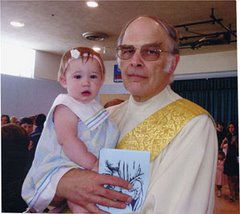Matthew 17:1-9
As you know, Pope John
Paul II added five mysteries to the Rosary; he called them the
“Mysteries of Light” or as we say, the Luminous mysteries. We
normally say them on Thursdays. They basically are little snapshots
of the life of Jesus between his being found in the temple and his
agony in the garden. They remind us that as important as Christmas
and Easter are, Jesus spent three years wandering around Palestine,
teaching, working miracles, and above all, forming his disciples.
One of the mysteries of
light is the Transfiguration. The story is told in the Gospels of
Matthew, Mark and Luke, all a little different, but basically the
same. In the Gospel of John, the author may have been referring to
it when he says, “We have seen his glory, the glory of the one and
only Son, who came from the Father, full of grace and truth.”
The Transfiguration was
carried out in the presence of three of the twelve apostles. Why
these three? It makes sense that Peter was there, after all, he had
been made the head of the apostles by Jesus. Thomas Aquinas says
that James was there because he was the first apostle to be martyred.
And John, who according to tradition was the only apostle not to be
martyred, was also the last to die. John, of course, was also the
one Jesus trusted to take care of his mother. So these three are the
closest to Jesus, and the only ones who will actually witness the
transfiguration.
But after this
life-changing event, which leaves the three apostles nearly
speechless, except for Peter, of course, Jesus tells them to tell no
one about what they have witnessed until after he rises from the
dead. So the whole event is kind of puzzling.
When I was going to
Catholic grade school I remember one of our teachers telling us that
Jesus did this so that the apostles would have faith and be
strengthened when they witnessed his crucifixion. That seemed to
make sense, but then if that was the case, it didn't work. The
apostles abandoned Jesus when he was crucified; Peter denied him
three times; and after the crucifixion they went into hiding. They
don't seem to have been strengthened. In fact, up until the
Resurrection, the three apostles may have thought they had just had a
bad dream. After the transfiguration everything goes back to normal
in the blink of an eye.
But there may have been
another reason. When you think about Jesus' life, he worked
miracles, of course. But he wasn't the only one. In the Old
Testament, many of God's prophets worked miracles, including Moses
and Elijah. Jesus was a great teacher; but except for a few things,
most of what he taught could be found in the writings of the
Prophets, especially Isaiah. In fact his teachings about how we are
to care for each other were found in other religions as well. And
even rising from the dead – Although Jesus' resurrection was
different, the people of that time did not see being wakened from the
dead as something that indicated that you were God. Jesus himself
raised some people from the dead – as did the apostles Peter and
Paul, as did the prophet Elijah.
And that is probably why
the Transfiguration is so important. Once Jesus rose from the dead
and the apostles remembered the Transfiguration, you had the
beginnings of the central doctrines of Christianity – the
Incarnation and the Trinity.
The apostles remembered
three things from the Transfiguration – first, something happens to
Jesus which reveals his divinity. His face shone like the sun, and
his clothing became white as light. I'm sure the apostles
remembered that when Moses had encountered God people could not look
at his face. Second, Jesus is conversing with Moses and Elijah.
Moses founded the religion of Israel. Elijah was the great prophet
who single-handedly withstood the attempt by Queen Jezebel to
substitute her religion for the Jewish religion. And perhaps the
apostles remembered Jesus saying “Before Abraham was born, I am!”
Because here was Jesus, speaking with people long dead. And
finally, they hear the voice of the Father naming Jesus his Son, and
commanding the apostles to listen to Him. The Father, who has spoken
to Moses and Elijah, as well as Adam and Noah and Abraham and various
others throughout Jewish history, speaks to the human race this one
last time; from now on his Son will speak for him.
The transfiguration by
itself could have been a dream, a hallucination. The Resurrection by
itself only proved that God could raise someone from the dead. But
put them together, and you can see that Jesus is divine as well as
human; that is what the light shining from his face and the garments
show them. And the seeds of the Trinity are here as well; because we
see Jesus is divine; we see that he transcends time and space; we see
that he is called “son” and we hear the Father tell us to listen
to him. When God becomes Man he makes it possible for us human
beings to take on Divinity. Because we are brothers and sisters of
Jesus, we share in his inheritance. We are adopted children of God,
and divinity can shine through us as well. And when we understand
that God is Trinity, three persons emptying themselves out into each
other, we understand that at the heart of creation is love, that Love
is why there is anything at all.
Christianity is unique
among all the religions of mankind, because we believe in the
Incarnation and the Trinity. For two thousand years we have
believed, but we are still working out what these mysteries mean and
what they tell us about God and our relationship to him. And perhaps
that is why the Transfiguration is so important – because Jesus
gave them a glimpse of these two central mysteries of our faith there
on the mountain.



































